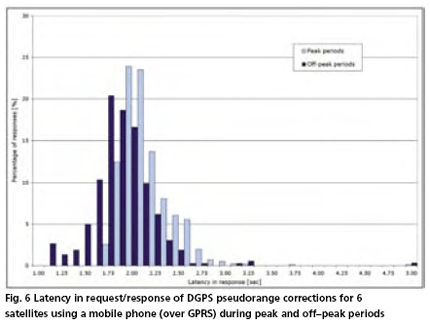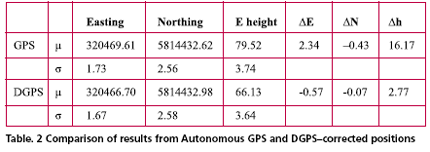| LBS | |
Augmentation of low-cost GPS receivers
Preliminary test resultsLatency in data TransmissionCritical to real and near real time applications is the delay (or latency) in the time taken for a DGPS correction to be received by the rover. In contrast to the streaming technique, the latency considered in this paper is the time taken for (1) the request to be sent to the DGPS Web service, (2) a correction to be determined and (3) the corresponding corrections to be sent back to the client. Figure 6 shows the latencies in transmission of DGPS corrections during peak and off–peak periods using a mobile phone and a GPRS connection. The average latencies from various tests show a mean of 1.86 seconds during off–peak periods and 2.12 seconds during peak periods. These results are based on a series of tests conducted over two weeks and are representative of the Melbourne CBD environment only. In all cases, none of the messages were found to be corrupted or degraded in any way. The latencies associated with the sending of reference station information to the CORS Web service (over a 1.5 Mb/s connection) is almost instantaneous and such, is not presented herein. Previous research and development in Internet–based DGPS systems using data streaming has indicated similar results (Weber et al, 2004, for example). However, the (two–way) Web services architecture generally shows greater latencies over those achieved through (one–way) Internet streaming. Notwithstanding the influence of bandwidth, network congestion, mobile phone infrastructure performance, server performance and the like, the primary cause of the additional latency comes as a result of XML tag bloat and sending data in plain text. If each message were compressed into binary format, the latencies could be reduced. The latency may be further reduced if the entire message was sent as a character delimited string. However, sending multiple data elements in a single string would be contrary to the intention of the OGC and W3C interoperability standards. DGPS CorrectionsTable 2 shows the positioning accuracy results achieved by the Web services DGPS prototype described in this paper. The results show the difference between the average (or expected) values and standard deviations obtained from the autonomous GPS and DGPS–corrected positions over 30 minutes (1 second observations) with a 15° elevation mask. As shown by Table 2, the effect of the spatially correlated GPS errors are greatly reduced by the DGPS technique. However, as indicated by the standard deviations in both GPS and DGPS estimates, the DGPS–corrected positions still suffer from large random errors. Web Services for other GPS applicationsThis paper has focussed on the single baseline (differential) pseudorange correction technique for augmenting autonomous GPS positions. However, the principle of the Web services architecture may be used for exchanging a variety of GNSS related data, and applied to other GNSS positioning applications. Typical applications may include multi–station relative positioning, the dissemination of satellite orbit and clock corrections for Precise Point Positioning (PPP), and the monitoring of CORS network and receiver performance. The one–way streaming of data over the Internet has been shown by other research to be a satisfactory method of disseminating DGPS corrections. As described in §5, results from this prototype indicate that Internet streaming offers marginally better latencies than the Web services architecture. However, where the method of augmentation requires the specific location of the roving receiver relative to one or more reference stations, two–way communications is needed. For instance, the interpolation of the differential correction for a rover based on the nearest surrounding CORS receivers requires the rover’s approximate location. As indicated by the prototype, the Web services architecture facilitates applications of this nature by enabling the user to supply measurements of any type, such as approximate position, observed pseudoranges and/or carrier– phase measurements. In the interest of multi–station RTK and Virtual Reference Station (VRS) applications, Web services can provide an efficient, secure and reliable source of platform–independent (or receiver independent) communication. Web services offer significant advantages for platform independent monitoring of CORS network receivers. Notwithstanding the fact that many systems have long been in place for exchanging data between reference station receivers, Web services offer the ability to integrate receiver types of any make, provided that there is a means for sending data over TCP/IP. It follows that Web services can be used to interact with (or configure) remote GPS receivers from a central processing system securely from any location, wirelessly or not. Experience has shown that Web services communications over a (wired) 1.5 Mb/s Internet connection is almost instantaneous, showing that multi–reference station application performance would not be significantly degraded. Discussion and conclusionThis paper shows that XML Web services are a simple, efficient and secure means for exchanging GPS augmentation information over the Internet. Web services offer some considerable advantages. Web services offer a platform independent way of augmenting GPS and Web enabled mobile devices capable of reaching the Internet (wirelessly or not) with correction information from existing CORS networks. It follows that software to consume a Web service can be developed by almost any programming language. Almost any hardware device capable of sending data over TCP/IP may be used. Since the Web services architecture allows for two– way communication, location–centric applications (i.e. multi–reference station approach) can benefit from this method of Internet augmentation. Web services can further provide opportunities for implementing encryption algorithms, secure transaction monitoring, and user authentication. Typical latencies for Web services communications can, in general, be expected to decline as mobile communications infrastructure is upgraded. The exchange of GPS augmentation information via the Web services architecture also has its disadvantages. Strictly speaking, Web services architecture introduces larger latencies than streaming methods due to XML–message bloat. Since the Web services architecture disseminates information via two–way “request and consume” communications, additional latencies are introduced. For sub–second applications, Web services offer less than optimal performance over wireless connections. Whilst not necessarily restricted to the Web services approach, the main disadvantages come as a result of: • Poor wireless/mobile coverage across rural areas which are dominant throughout Australia. • Network congestion has the potential for introducing large latencies, even for simple data transmission. • There can be no guarantee that a data packet will arrive by a certain time, if at all. AcknowledgementsThe authors would like to gratefully acknowledge the scholarship funding provided by Natural Resources, Mines and Energy (NRM&E, QLD) and the department of Geomatics, University of Melbourne. All hardware and software development tools used in this investigation have also been provided by NRM&E and the Department of Geomatics. ReferencesGao Y and Liu Z (2001), Differential GPS Positioning over Internet, Journal of Geospatial Engineering, Vol. 3, No. 1, 1–7. Hofmann–Wellenhof B, Lichtenegger H and Collins J (2001) GPS Theory and Practice, 5th edition, revised, Springer–Verlag Wien, New York. Kechine MO, Tiberius CCJM and van der Marel H (2003) Network Differential GPS: Kinematic Positioning with NASA’s Internetbased Global Differential GPS, Journal of Global Positioning Systems, Vol. 2, No. 2, 139–143 Lenz E (2004) Networked Transport of RTCM via Internet Protocol (NTRIP), Proceedings of the FIG Working Week 2004, Athens, Greece, 22–27 May. Monteiro LS, Moore T and Hill CJ (2004) What is the Accuracy of DGPS?, Presented at the European Navigation Conference GNSS 2004, Rotterdam, The Netherlands, May. Muellerschoen R J, Bertiger WI and Lough M (2000), Results of an Internet-Based Dual-Frequency Global Differential GPS System, Proceedings of the IAIN World Congress, San Diego, CA, June. RTCM SC–104, (2001) RTCM Recommended Standards for Differential GNSS Service, Version 2.3, 20 August, Radio Technical Commission for Maritime Services, Alexandria, Virginia. Satirapod C, Rizos C and Wang J (2001) GPS Single Point Positioning With SA Off: How Accurate Can We Get? Survey Review, 36(282), 255-262. SiRF (2004) SiRF Binary Protocol Reference Manual, SiRF Technology, San Jose, CA, Revision 1.1, February 2004. Weber G, Dettmering D and Gebhard H (2004) Networked Transport of RTCM via Internet Protocol (NTRIP), unpublished, Available online: W3C (2002) XML Encryption Syntax and Processing – W3C Recommendation, Eastlake D, Reagle J (eds), 10 December, Available online: http://www.w3.org/TR/xmlenc-core/. |
||||||||||||||||||||||||||||||
|
||||||||||||||||||||||||||||||
|
Pages: 1 2

















 (1 votes, average: 1.00 out of 5)
(1 votes, average: 1.00 out of 5)




